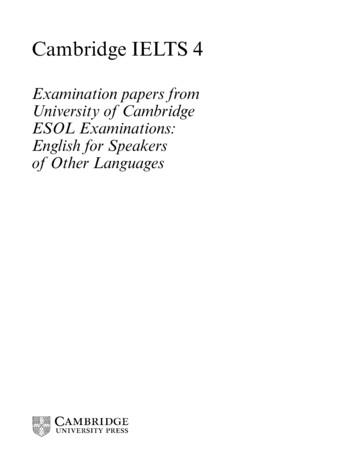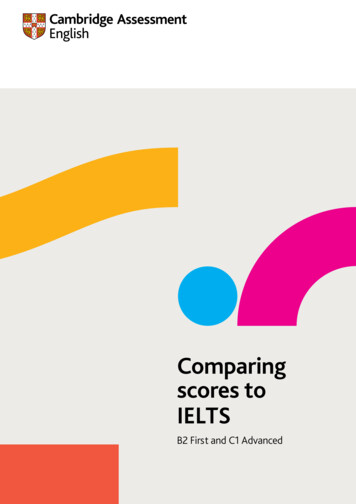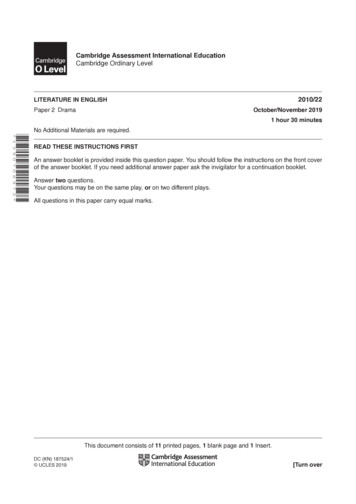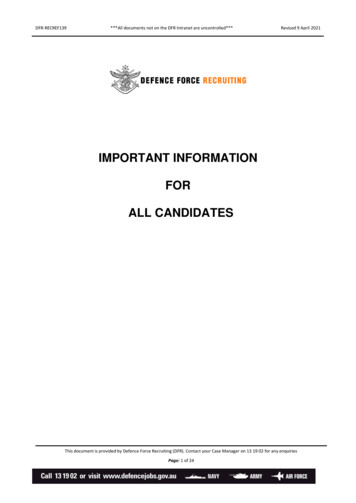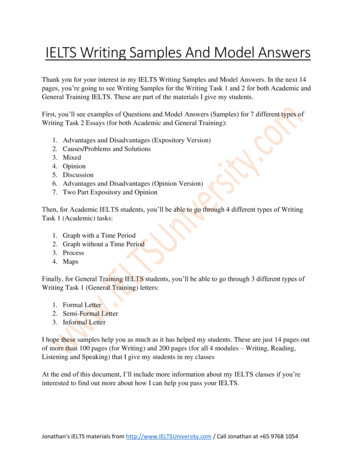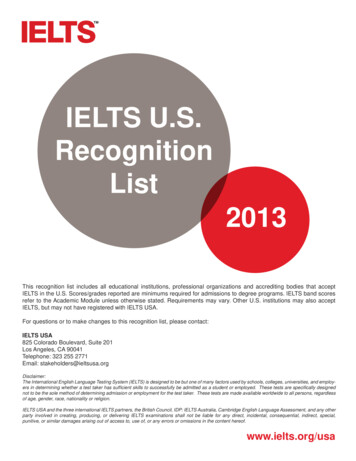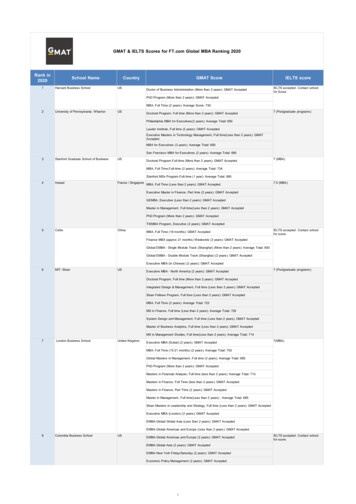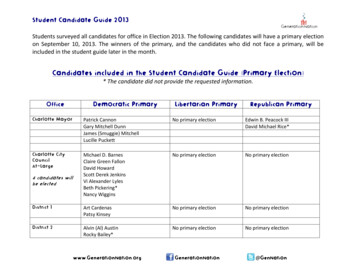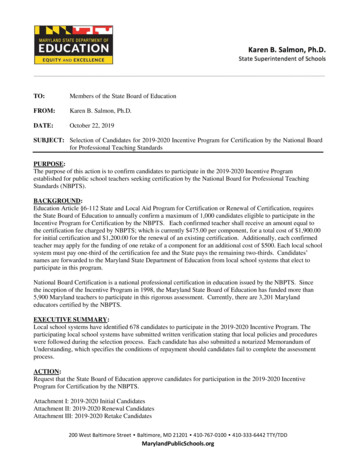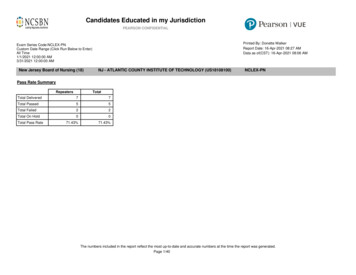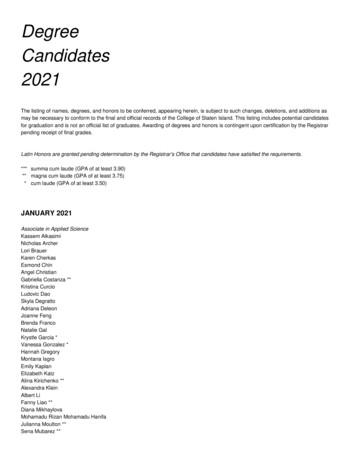
Transcription
Informationfor CandidatesIntroducing IELTSto test takerswww.ielts.org
The test thatopens doorsaround the worldThis booklet containsimportant informationto help you preparefor your IELTS test.IELTS, the International EnglishLanguage Testing System, isdesigned to assess the languageability of people who want tostudy or work where English isthe language of communication.IELTS is recognised and accepted byover 9,000 organisations worldwide,including universities, employers,professional bodies, immigrationauthorities and other governmentagencies. For a list of organisationsthat accept IELTS scores,visit www.ielts.org/recognition.Accessible and convenientIELTS is offered up to four times a month in more than140 countries. Tests are held on Saturdays and Thursdays.To find out test dates in your area, please contact yournearest IELTS test centre. A list of all IELTS test locationsworldwide is available at www.ielts.org.The international testIELTS is internationally focused in its content. For example,texts and tasks are sourced from publications from all overthe English-speaking world; a range of native-speaker accents(North American, Australian, New Zealand, British etc.) areused in the Listening test; and all standard varieties of Englishare accepted in test takers’ written and spoken responses.The test that’s tried and trustedIELTS has been developed by some of the world’s leadingexperts in language assessment, and is supported byan extensive programme of research, validation andtest development.The level of the testIELTS is designed to assess English language skills acrossa wide range of levels. There is no such thing as a pass orfail in IELTS. Results are reported as band scores on a scalefrom 1 (the lowest) to 9 (the highest).The IELTS band score scale9Expert user8Very good user7Good user6Competent user5Modest user4Limited user3Extremely limited user2Intermittent user1Non user0Did not attempt the testIELTS for UK Visas and ImmigrationFind out how you can use an IELTS result forthis purpose at www.ielts.org/unitedkingdom.For more information on going to or staying in theUK, visit www.gov.uk.
Preparing for your testTest formatMake sure you are ready to demonstrate your English1. Familiarise yourself with the format of the test by reading thisbooklet. If you would like more information about the formatof the test and the question types used, you can find the testspecifications at www.ielts.org/testformat.There are two modules to choose from –Academic and General Training.2. Practice using sample questions from www.ielts.org/sampletest.3. Consider doing a practice test. Two volumes of Official IELTSPractice Materials are available for purchase from test centresor at www.ielts.org/prepare. These materials include a fullpractice test with answers, and sample Writing and Speakingperformances with examiner comments.4. Consider enrolling in a preparation course to improve yourperformance in the test. IELTS test centres and languageschools around the world offer IELTS preparation courses.More information is available h.org/ieltswww.ielts.org/usaKnow the IELTS rules and regulationsIt’s important to familiarise yourself with the IELTS rules andregulations. These are laid out in the Notice to Candidatesand Declaration which are included in the application form.When you sign the application form declaration, or agree tothe terms online, you are confirming that you have read andunderstood the IELTS rules and regulations and agree toabide by them.IELTS AcademicIELTS Academic is for test takers wishing to study atundergraduate or postgraduate levels, and for thoseseeking professional registration.IELTS General TrainingIELTS General Training is for test takers wishing to migrate to anEnglish-speaking country (Australia, Canada, New Zealand, UK),and for those wishing to train or study at below degree level.Each organisation sets its own entry requirements. In some casesboth Academic or General Training may be accepted. If you arein doubt as to which to take, you should contact the organisationyou are applying to in order to check their requirements.You are tested on all four language skills – listening, reading,writing and speaking, unless you have an exemption due toa disability (see section on special requirements). Everyonetakes the same Listening and Speaking tests. There aredifferent Reading and Writing tests for IELTS Academic andGeneral Training.The Listening, Reading and Writing tests must be completedon the same day. The order in which these tests are takenmay vary. There are no breaks between these three tests.The Speaking test may be taken up to seven days beforeor after the other three tests.Register as soon as possibleWhen you feel you are ready to take the test, you need toregister for a test date with an IELTS centre. Contact thecentre as soon as possible, as the number of test takerswho can take the test on a particular date may be limited.You will need to pay the test fee when you register.Tell your centre if you have special requirementsIn order to ensure that the language ability of all test takersis assessed fairly and objectively, IELTS provides acomprehensive service for test takers who have specialrequirements, including specific learning difficulties, hearingdifficulties and visual difficulties.If you require a modified version of the test, for example a LargePrint or Braille version, you must give the test centre threemonths’ notice. This notice period is necessary for the modifiedtest version to be prepared. If your circumstances require specialadministrative arrangements to be made, for example if you needextra time or you need to use access technology such as a screenreader, you must give the test centre six weeks’ notice. Pleasecontact your test centre to discuss your requirements. Any specialarrangements agreed are in accordance with the Joint Councilfor Qualifications (JCQ).ListeningAcademic ReadingGeneral Training ReadingAcademic WritingGeneral Training WritingSpeaking3
The four components of the IELTS testListeningTimingApproximately 30 minutes (plus 10 minutes’ transfer time).QuestionsThere are 40 questions. A variety of question types are used,chosen from the following: multiple choice, matching, plan/map/diagram labelling, form completion, note completion,table completion, flow-chart completion, summary completion,sentence completion, short-answer questions.Test Parts There are 4 sections: Section1 is a conversation between two people setin an everyday social context (e.g. a conversation inan accommodation agency).Section 2 is a monologue set in an everyday social context(e.g. a speech about local facilities or a talk about thearrangements for meals during a conference).Section 3 is a conversation between up to four peopleset in an educational or training context (e.g. a universitytutor and a student discussing an assignment, or a groupof students planning a research project).Section 4 is a monologue on an academic subject(e.g. a university lecture).Each section is heard once only.A variety of voices and native-speaker accents are used.Skills assessedA wide range of listening skills are assessed, including: u nderstanding of main ideas u nderstanding of specific factual information r ecognising opinions, attitudes and purpose of a speaker f ollowing the development of an argument.MarkingEach correct answer receives 1 mark. Scores outof 40 are converted to the IELTS 9-band scale.Scores are reported in whole and half bands.ReadingTiming60 minutes (no extra transfer time).QuestionsThere are 40 questions. A variety of question types areused, chosen from the following: multiple choice, identifyinginformation (True/False/Not Given), identifying a writer’sviews/claims (Yes/No/Not Given), matching information,matching headings, matching features, matching sentenceendings, sentence completion, summary completion,note completion, table completion, flow-chart completion,diagram label completion, short-answer questions.Test PartsThere are 3 sections. The total text length is 2,150-2,750 words.Academic ReadingEach section contains one long text. Texts are authentic andare taken from books, journals, magazines and newspapers.They have been written for a non-specialist audience and areon academic topics of general interest. Texts are appropriateto, and accessible to, test takers entering undergraduate orpostgraduate courses or seeking professional registration.Texts range from the descriptive and factual to the discursiveand analytical. Texts may contain non-verbal materials suchas diagrams, graphs or illustrations. If texts contain technicalterms, then a simple glossary is provided.General Training ReadingSection 1 contains two or three short factual texts, one of whichmay be composite (consisting of 6-8 short texts related by topic,e.g. hotel advertisements). Topics are relevant to everyday lifein an English-speaking country.Section 2 contains two short factual texts focusing on workrelated issues (e.g. applying for jobs, company policies, pay andconditions, workplace facilities, staff development and training).Section 3 contains one longer, more complex text on a topicof general interest.Texts are authentic and are taken from notices, advertisements,company handbooks, official documents, books, magazinesand newspapers.Skills assessedA wide range of reading skills are assessed, including: r eading for gist r eading for main ideas reading for detail u nderstanding inferences and implied meaning r ecognising writer’s opinions, attitudes and purpose f ollowing the development of an argument.MarkingEach correct answer receives 1 mark. Scores outof 40 are converted to the IELTS 9-band scale.Scores are reported in whole and half bands.For test specifications visit www.ielts.org/testformatFor marking information visit www.ielts.org/criteriaFor sample questions visit www.ielts.org/sampletestIELTS for UK Visas and ImmigrationFind out how you can use an IELTS result for this purposeat www.ielts.org/unitedkingdom. For more information ongoing to or staying in the UK, visit www.gov.uk.
WritingTiming60 minutesTasksThere are 2 tasks. You are required to write at least150 words for Task 1 and at least 250 words for Task 2.Test PartsThere are 2 parts.Academic WritingIn Task 1, you are presented with a graph, table, chart ordiagram and are asked to describe, summarise or explainthe information in your own words. You may be asked todescribe and explain data, describe the stages of a process,how something works or describe an object or event.In Task 2, you are asked to write an essay in responseto a point of view, argument or problem.The issues raised are of general interest to, suitable forand easily understood by test takers entering undergraduateor postgraduate studies or seeking professional registration.Responses to Task 1 and Task 2 should be writtenin an academic, semi-formal/neutral style.General Training WritingIn Task 1, you are presented with a situation and are asked towrite a letter requesting information or explaining the situation.The letter may be personal or semi-formal/neutral in style.In Task 2, you are asked to write an essay in response to apoint of view, argument or problem. The essay can be slightlymore personal in style than the Academic Writing Task 2 essay.Topics are of general interest.Skills assessedIn both tasks, you are assessed on your ability towrite a response which is appropriate in terms of: c ontent the organisation of ideas t he accuracy and range of vocabulary and grammar.Academic WritingIn Task 1, depending on the task type, you are assessed on yourability to organise, present and possibly compare data; to describethe stages of a process or procedure; to describe an object orevent or sequence of events; to explain how something works.In Task 2, depending on the task type, you are assessed onyour ability to present a solution to a problem; to present andjustify an opinion; to compare and contrast evidence, opinionsand implications; to evaluate and challenge ideas, evidenceor an argument.General Training WritingIn Task 1, depending on the task type, you are assessed on yourability to engage in personal correspondence in order to: elicitand provide general factual information; express needs, wants,likes and dislikes; express opinions (views, complaints etc.).In Task 2, you are assessed on your ability to provide generalfactual information; to outline a problem and present a solution;to present and possibly justify an opinion; to evaluate andchallenge ideas, evidence or an argument.MarkingYou are assessed on your performance on each taskby certificated IELTS examiners according to the IELTSWriting test assessment criteria (Task Achievement/Response,Coherence and Cohesion, Lexical Resource, GrammaticalRange and Accuracy). The public version of the assessmentcriteria can be found at www.ielts.org/criteria.Task 2 contributes twice as much as Task 1 to the Writing score.Scores are reported in whole and half bands.SpeakingTiming11-14 minutesTest PartsThere are 3 parts.Part 1 Introduction and interview (4-5 minutes)The examiner introduces him/herself and asks you to introduceyourself and confirm your identity. The examiner asks yougeneral questions on familiar topics, e.g. home, family, work,studies and interests.Part 2 Individual long turn (3-4 minutes)The examiner gives you a task card which asks you to talk abouta particular topic and which includes points you can cover in yourtalk. You are given 1 minute to prepare your talk, and are givena pencil and paper to make notes. You talk for 1-2 minutes onthe topic. The examiner may then ask you one or two questionson the same topic.Part 3 Two-way discussion (4-5 minutes)The examiner asks further questions which are connectedto the topic of Part 2. These questions give you an opportunityto discuss more abstract issues and ideas.Sk
IELTS is offered up to four times a month in more than 140 countries. Tests are held on Saturdays and Thursdays. To find out test dates in your area, please contact your nearest IELTS test centre. A list of all IELTS test locations worldwide is available at www.ielts.org. The international test IELTS is internationally focused in its content. For example, texts and tasks are sourced from .
